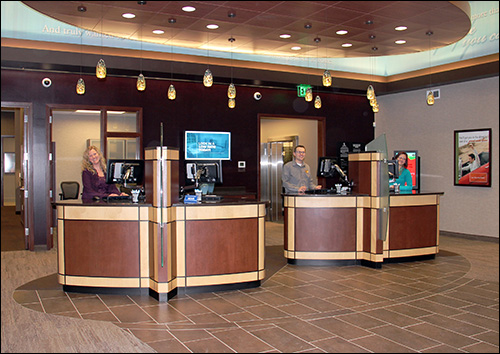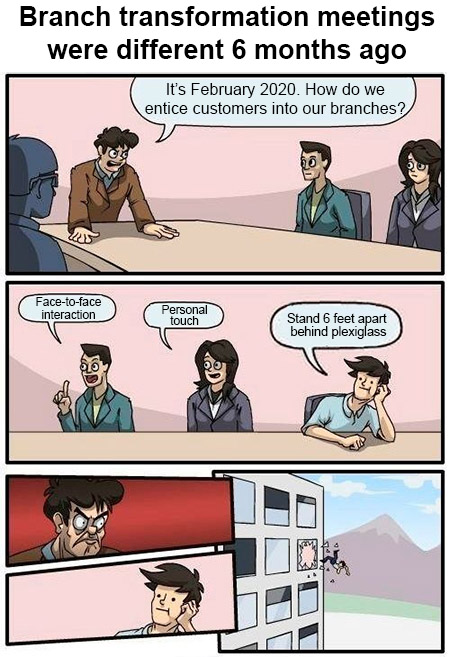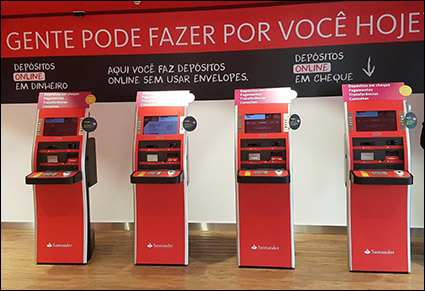In our previous article, we addressed one of the persistent questions that’s followed us through the past six months: Will physical bank branches survive after COVID-19? While we think it’s a foregone conclusion that the brick-and-mortar branch will remain part of the banking experience, it’s almost equally certain that some things will be different.

But what does “different” mean? Will branches be mostly the same as before, but with interim changes? What about all those futuristic branch concepts that were being discussed before, with open floor plans and more face-to-face interaction – do those ideas just go out the window now? Are there parts of branch transformation plans that would actually work better in a post-COVID world?
The short answer to all three of those questions is: “Yes – kind of.” Without any further explanation, that’s a timid response to be sure, so let’s talk about how we arrive there. To start, we need to make a few (relatively safe, we think) assumptions about customer behavior:
It’s about customer preferences, not regulations.
Even if all official COVID restrictions were lifted tomorrow, that won’t bring every customer straight back into the branch like it’s an on/off switch. Instead, it’s a scale.
In other words, even though most customers had their choices made for them over the past several months due to the restrictions, some of them would still make the same choices on their own. For simplicity’s sake, we’ll say a third are gung-ho about returning to normal, a third still want to be very cautious, and the rest are somewhere in the middle. That has important implications for the next key point …
The common denominator will win out.
Notice we didn’t say “lowest” common denominator, because there is no high or low here. There is only the spectrum of customer preferences, and the choices you can make that will get the most of them to come back.
No business would make a decision that drove away a third of its customers, right? Well, the reality facing most banks is that a third of their customers are – for lack of a better way of putting it – scared to death of coming in close contact with other people. If they don’t feel safe, they’ll stay away, period. On the opposite side of the risk-aversion spectrum, there may be some low level of grumbling about excessive precautions, but we’d expect most of those customers to show up regardless.
The bottom line is: Banks will most likely do whatever it takes to make the most nervous customers comfortable, for as long as those customers exist in appreciable numbers. That is the common denominator. So, for the foreseeable future, every branch plan is probably going to include barriers, distancing, and lower face-to-face interaction as an option, if not the default. Which allows us to infer the next unsung truth:
The first step for physical branches will simply be trying to stabilize.

What does this mean? It’s tempting to say, “getting back to business as usual,” but that would only be half true. We should expect to see most of the temporary safety measures left in place for at least the next several months, with perhaps incremental testing of new technology and branch design features to gauge response. But it would be surprising to see anyone jumping feet-first into an overhaul of their entire branch network.
Besides the uncertainty of predicting customer behavior, many banks are also bracing for a reckoning with other impending effects of the pandemic, especially a possible wave of loan and mortgage defaults on levels not seen since 2008. Small changes that “do more with less” to improve customer confidence are likely, but wholesale changes are probably reserved for a more stable long-term situation. (Will those changes even be needed once things are more stable? Only time will tell.)
What this implies for the short to medium term is that financial institutions will be looking to find the correct balance between adjusting to new customer preferences and protecting the banks’ own ideal positions, without committing permanently to either.
Loosely translated: Customers have become accustomed to transacting business digitally in recent months, and some – but not all – actually prefer certain elements of the digital experience. Some of those preferences also happen to coincide with things that the banks want. Self-service and assisted self-service have long been on the table, both as overhead-reduction measures and as customer convenience initiatives, and there might be no better time to experiment with them.
Banks might not be in a rush to start ripping up the floorboards entirely, though. Before major, permanent change takes effect, there are going to be interim trials and incremental measures. For example, it would not be surprising to see banks try to backfill some of their current reduced staffing levels by bringing more self-service options into the branch. Some customers will be happy to see more automation. Others will be indifferent. How many of each will there be, and will their numbers shift over time? A lot of that still remains to be figured out.
In the meantime, banks should be wary of confusing “quick fixes” with a cohesive, streamlined branch experience that properly implements automation. Customers’ post-COVID (or mid-COVID) expectations may offer a good proving ground for new approaches but are always subject to change. In other words, it is a good time to be experimenting within reason, but it will still be some time before the real winners emerge.
So, did COVID kill the branch of the future?

What if you separated the “face-to-face” part of that definition from the rest of it? Could the other ideas be useful in a post-COVID Branch of the Future?
The answer is that yes, they could be very useful – maybe even more so than they would have been six or eight months ago. An appealing branch layout may be more important than ever; it is just that what is appealing may have shifted for the time being. Clever use of technology will be central to winning over certain segments of the customer base who might otherwise have stayed away.
In fact, much of the same technology being talked about before will be just as useful now; it might just be used in slightly different ways.
Interactive Teller Machines (also known as video teller stations) have been on the future-branch radar for a long time, largely because of their implications for centralized staffing and overhead reduction. But now, there could be a safety element to them too. Transaction kiosks – think streamlined, ATM-like self-service stations for the lobby – have been used heavily for line management and customer convenience, especially overseas. In the post-COVID branch, their portability also makes them great if you’re rearranging your floor plan with social distancing in mind. Cash recyclers (and other cash-handling technology) suddenly have a larger role to play than boosting accuracy and efficiency.
In many ways, the answer is that COVID-19 didn’t kill the Branch of the Future, so much as break it up and move the pieces around. It will still take a while to put the puzzle together, but the good news is that it won’t be necessary to start over from scratch.





